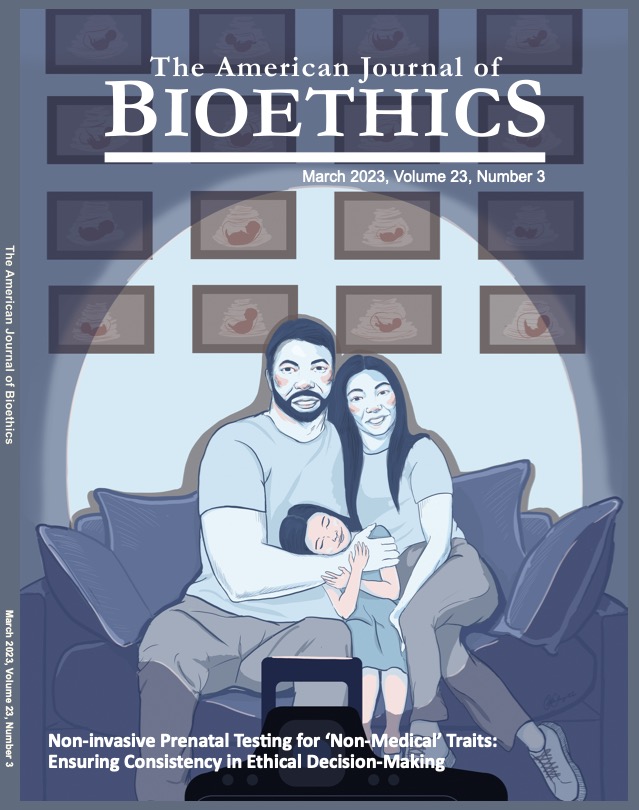
This editorial can be found in the March 2023 issue of the American Journal of Bioethics. You can find it here: https://www.tandfonline.com/toc/uajb20/23/3
Bowman-Smart et al. have written a thoughtful and balanced essay examining some of the ethical issues surrounding large scale use of noninvasive prenatal testing (NIPT) and the thorny question of whether it should be used to test for non-medical traits. My perspective is that of a scientist and parent and not that of a professional ethicist, and with that caveat I would like to discuss a few points that I think are worth emphasizing.
The first point I would like to make is that the ethical issues raised by Bowman-Smart et al are not future possibilities and are not limited to NIPT—they are already relevant in today’s world in two important contexts: first, for pregnancies created by in vitro fertilization (of which there are ∼70,000 every year in the United States and about half a million globally) and second, for those pregnancies which undergo invasive testing such as amniocentesis (200,000 every year in the United States) or chorionic villus sampling. In all those cases, fetal genetic material is obtained and tested for genetic disorders, and there is substantial scientific literature showing that using modern sequencing approaches, any trait in the fetal genome can be tested for. So these are not theoretical ethical questions, nor are they specifically tied to NIPT—they are practical questions with an immediate urgency.
If there is a distinction to be drawn between NIPT on the one hand and IVF and invasive testing on the other, it is the practical scale at which these ethical questions will intersect modern parenthood. The number of pregnancies each year in the United States is about six million, and part of the power of NIPT is that it is a simple blood test with no risk to the mother or fetus, and thus could be used for all pregnancies. And it is worth noting that it has been shown that the fetal genome can be noninvasively sequenced from a maternal blood sample, thus extending NIPT to any genetic trait. So, the ethical questions of prenatal testing for non-medical genetic traits could in principle grow from today’s status quo of affecting a small fraction of all pregnancies to one that affects virtually every pregnancy.
As a second point, it is important to remember that in many, and perhaps most questions of interest, the genome is not determinative nor is it perfectly predictive—the results one gets from genetics are often probabilities and the role of genetics in certain traits often has small effect sizes. And there are many traits which have so-called “partial penetrance,” which is scientific jargon for saying the mutation is not perfectly predictive. So, for many traits there is only marginal benefit to genome-based selection. And as Bowman-Smart et al point out, it is also true that many traits are coupled together—they have a particularly compelling example in which they discuss how risk of schizophrenia and increased creativity are linked together. Parents who would be selecting against risk of schizophrenia (generally an unwanted trait) would also potentially be selecting against high creativity (generally a desired trait). It is thus important to emphasize that in general it is very difficult to make practical choices about non-medical traits or even sub-clinical traits based solely on genetic information.
My third and final point is that the decision to terminate a pregnancy is radical and something most people only use in the case of severe medical conditions. Pregnancy is physically and emotionally challenging; it involves massive physiological changes as well as health risk for mother, and it is hard to believe many people would make termination decisions based on a handful undesired non-medical traits their future child may be at risk for. Therefore, the notion discussed by Bowman-Smart et al of being obligated to choose the “best” possible baby just does not seem practical when applied to natural pregnancies. (The situation is much different in IVF, where multiple embryos are created and by the very nature of the process one must choose an embryo for transfer.)
So, at some level there is a crucial question of whether some potential parents would terminate a pregnancy based on non-medical traits. Unfortunately, the answer to that question is known and it is “yes.” It has been well documented that in many countries where there is a cultural preference for sons over daughters, the ratio of boys to girls is skewed and not biologically plausible. This is particularly relevant to the discussion here because starting in the 1980s these questions became linked to the development of a prenatal testing technology: namely, ultrasound. Coincident with the widespread introduction of this technology, South Korea, India and China all began reporting very high sex ratios at birth, and under China’s “One Child” policy up to one million excess male births were reported every year. Over time, this has resulted in estimates of 80 million missing females in China and India alone. It is thus apparent that when the cultural and legal stakes are high enough, parents will use technology to make decisions to terminate pregnancies based on non-medical traits.
Some countries have had success in combatting this problem. South Korea has been particularly successful by combining public awareness campaigns with enforcement of laws. Where does that leave one from an ethical perspective? I think that it is a question of watchful waiting to see if cultural attitudes toward non-medical trait selection arise in other contexts and having continued public discussions about the ethics of such approaches including the competing questions of parental autonomy versus societal needs. In that respect, Bowman-Smart et al. have written a timely article which raises questions that deserve to be broadly discussed now.
Disclosure Statement
S.R.Q. receives royalties from Stanford University for the invention of NIPT.